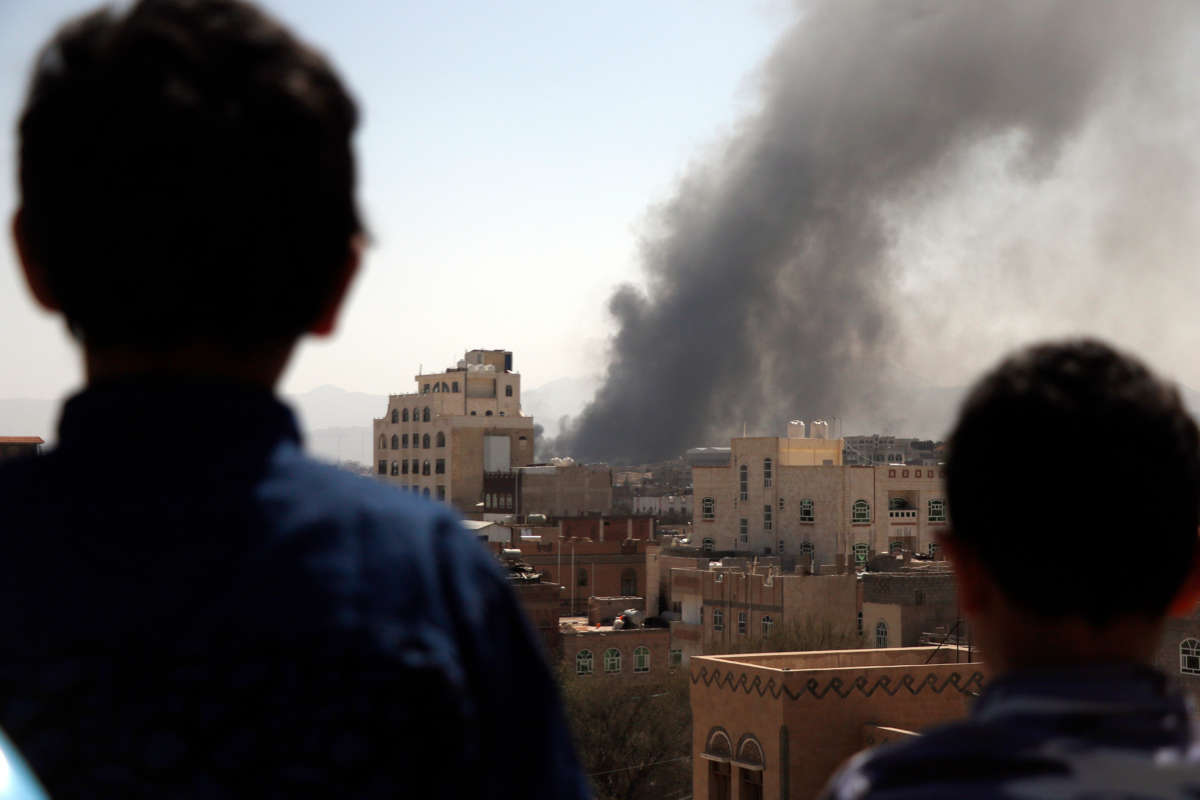A new analysis of global weapons sales published Monday revealed that the United States now accounts for well over a third of all arms exports worldwide over the last half decade and nearly half of these weapons of war were sold to nations in the Middle East — a region beset by war and conflicts unleashed and exacerbated by American foreign policy.
According to the new data on global arms transfers compiled and analyzed by the Stockholm International Peace Research Institute (SIPRI), a decrease in arms sales between 2016 and 2020 by Russia and China — the second and fifth exporters overall, respectively — was offset by increasing sales made by the other top five weapons exporters: U.S., France, and Germany. And while the sales remained steady compared to the 2011–2015 period, the report shows that the past decade still saw the highest levels of weapons sales worldwide since the height of the Cold War in the 1980s.
Over a third of the global weapons sold worldwide during the past five years came from the #UnitedStates. About half of US arms transfers went to the Middle East. @SIPRIorghttps://t.co/Iv09U0d0kh pic.twitter.com/hSsWYVAjfN
— DW Business (@dw_business) March 15, 2021
According to SIPRI’s analysis:
The United States remains the largest arms exporter, increasing its global share of arms exports from 32 to 37 per cent between 2011–15 and 2016–20. The USA supplied major arms to 96 states in 2016–20, far more than any other supplier. Almost half (47 per cent) of US arms transfers went to the Middle East. Saudi Arabia alone accounted for 24 per cent of total US arms exports. The 15 per cent increase in US arms exports between 2011–15 and 2016–20 further widened the gap between the USA and second largest arms exporter Russia.
While international arms sales plateaued from 2016–2020 compared to the previous five-year period, the import of weapons increased sharply in the Middle East region — especially in Saudi Arabia, the world’s largest importer of weapons overall, as well as in Qatar and Egypt — all major customers of U.S. manufacturers.
“Middle Eastern states imported 25 per cent more major arms in 2016–20 than they did in 2011–15,” SIPRI noted, the largest increase of any regional bloc. “This reflected regional strategic competition among several states in the Gulf region. Saudi Arabia — the world’s largest arms importer — increased its arms imports by 61 percent and Qatar by 361 percent.” For its part, Egypt’s import of weapons increased by 136 percent over the past five years.
Who were the five largest arms exporters in 2016–20?
1) USA🇺🇸
2) Russia🇷🇺
3) France🇫🇷
4) Germany🇩🇪
5) China🇨🇳Together, they accounted for 76% of all exports of major arms in 2016–20. New SIPRI data on global #ArmsTransfers out now ➡️ https://t.co/QT5DB0nXPS pic.twitter.com/xi2TGybo95
— SIPRI (@SIPRIorg) March 15, 2021
Like with other goods, it remains unclear exactly how the Covid-19 pandemic impacted the international arms industry over the last year or how long such impacts will last.
“It is too early to say whether the period of rapid growth in arms transfers of the past two decades is over,” said Pieter D. Wezeman, senior researcher with the SIPRI Arms and Military Expenditure Programme.
“For example,” Wezeman added, “the economic impact of the Covid-19 pandemic could see some countries reassessing their arms imports in the coming years. However, at the same time, even at the height of the pandemic in 2020, several countries signed large contracts for major arms.”
Among those countries was the United Arab Emirates. While their weapon imports decreased over the last five years overall, a pending sale of 50 F-35 combat fighter jets — built by Lockheed Martin — shows the nation’s appetite for American weaponry remains very strong heading into the future.
Join us in defending the truth before it’s too late
The future of independent journalism is uncertain, and the consequences of losing it are too grave to ignore. To ensure Truthout remains safe, strong, and free, we need to raise $27,000 in the next 24 hours. Every dollar raised goes directly toward the costs of producing news you can trust.
Please give what you can — because by supporting us with a tax-deductible donation, you’re not just preserving a source of news, you’re helping to safeguard what’s left of our democracy.
